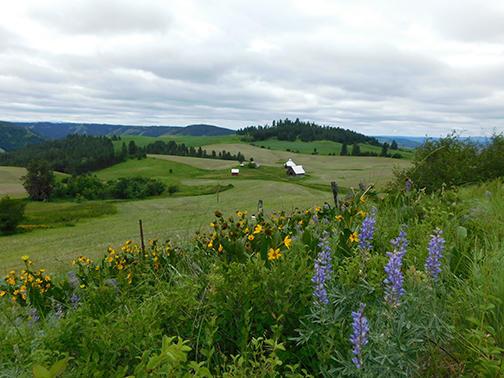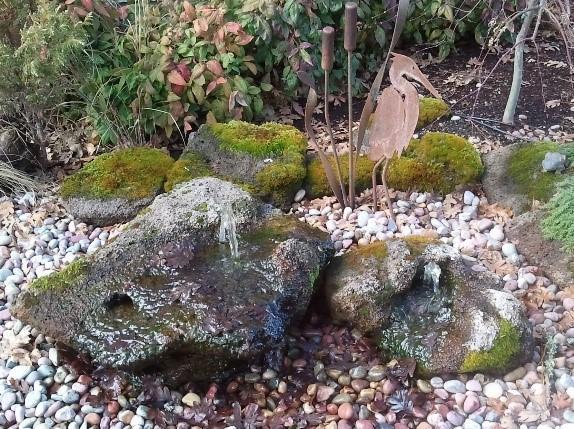Observing wildlife in nature is part of the joy of rural living. Private property can play a key role in wildlife habitat. However, wildlife is a large category, and each species has specific requirements.
If you manage your land to promote a diverse native habitat and support natural ecological processes and systems, many species will benefit. On the other hand, sometimes our actions can provoke nuisance behavior in wildlife, or invasive species can become problematic. Understanding the animals and plants that live in your area will improve your neighborhood wildlife relations.
The term “wildlife,” as used here, refers to more than just undomesticated animals. It also refers to plants and other organisms native to an area. Wildlife habitat consists of four components: water, food, shelter and space.
Many elements of habitat serve multiple purposes for wildlife. For example, a food source such as a fruiting shrub may also provide shelter and nesting habitat.
Identify what you have, what you want
The first step to improving your property for wildlife is to clarify your own goals. Get to know what species live in your area and assess habitat areas as they are now. This will help you focus your efforts.
- Identify your goals. Try to keep your expectations as realistic as possible. List wildlife that you would like to attract that are native to your region. What wildlife should be present, but are absent for some reason? If you are a gardener, you may not want to encourage animals that could damage plants. How will you discourage them, while encouraging others? Your local Extension office or state department of fish and wildlife are good resources that can help you identify the species you might like to encourage and the habitat resources they need to thrive.
- Get to know your species. List the animals, plants and other organisms currently found on your property, including native and non-native species. This list is a great way to identify needed improvements.
- Inventory your resources. What are your current habitat resources? These can include streams, ponds, oak habitats, native grasses, a mixture of hardwoods and conifers. Notice the diversity of wildlife species using these resources. Do you have a wide variety of birds and pollinators? Or only a few species? Do you think you should see more of certain species like monarch butterflies or Pacific treefrogs, for example? If possible, compare how wildlife use your neighbor’s property. Do you see more wildlife there? Try to identify the habitat features that the wildlife are using, such as fruiting shrubs or standing snags with nesting cavities for birds. This exploration can help you identify elements to enhance on your own property.
Participate in citizen science
Citizen science is the collection and analysis of data relating to the natural world by members of the general public, typically as part of a collaborative project with professional scientists. Participating in citizen science can be a great way to learn more about your local environment while contributing to scientific understanding.
Many online platforms capture the observations of amateur naturalists. Here are just a few to check out: eBird, iNaturalist, Project BudBurst and eMammal.
Provide water, food, shelter and space
Water
Most wildlife species need access to water for drinking, bathing or reproduction. If you have a freshwater ecosystem such as a stream, spring or wetland, it is vital to maintain or improve water quality for wildlife.
Uncontrolled grazing by livestock in or around riparian areas reduces the water’s value to fish and other wildlife, and to the landowners. Fencing out livestock, stabilizing banks and planting native plants all help to improve this ecosystem. For more details on managing riparian areas, see Streams and Riparian Areas: Clean Water, Diverse Habitat, EM 9244.
You can also build water features for wildlife, such as birdbaths, ponds, rain gardens and puddling areas for butterflies. These features attract wildlife of all kinds.
Use caution: Providing artificial sources of water can sometimes cause problems. Permanent ponds can become breeding areas for invasive bullfrogs or mosquitoes. Predators may be attracted to water sources, causing issues with domestic animals. If not cleaned, watering sources and birdbaths can spread disease among birds and deer. Contact your local fish and wildlife office for recommendations for your region.
Food
The best way to provide wildlife food is to plant native forbs, shrubs and trees. Native plants provide foliage, nectar, pollen, berries, seeds and nuts. In agricultural systems, consider incorporating cover crops and hedgerows.
Cover crops are planted primarily in agricultural ecosystems to maintain soil fertility and water quality, to control weeds, plant disease and pests, to create biodiversity and to encourage wildlife.
Hedgerows, fencerows or shelterbelts can provide diverse “edge” habitats at the interface of two or more plant communities, such as a woodland, crop field border or pasture.
Avoid invasive plants when choosing plants from nurseries. Verify with your nursery that plants you purchase are not invasive. Purple loosestrife (Lythrum salicaria), Japanese knotweed (Fallopia japonica), heavenly bamboo (Nandina domestica) and Scotch broom (Cytisus scoparius) are examples of ornamentals that have become serious management problems. Such aggressive aliens can decrease available habitat for native species and contribute to their decline. Consult your local native plant society or state agricultural office for lists of noxious species.
Shelter
Wildlife need places to escape from humans, predators and inclement weather. They also need safe places for raising young. Examples include patches of native trees, such as oaks and Ponderosa pines, and and dense areas of native shrubs, such as buckbrush (Ceanothus cuneatus). Brush piles are easy to build. Place them near feeding areas in yards, field edges or scattered in a large wooded or open lot.
A hedgerow or fencerow about 30 feet wide with a variety of native plants of differing heights provides wonderful cover habitat. Build nesting and roosting boxes for birds, bats and pollinators. Plant host plants for insects: milkweed for monarch butterflies, camas for bees.
Leave snags, logs and limbs to support wildlife and ecological processes. Some birds drill cavities in trees, which are then used in later years by bird and mammal species that cannot build their own cavities. Snags and downed wood play an important role in nutrient cycling.
Many of the features that provide shelter for wildlife are also potential fuels for wildfire. Work to balance habitat requirements with the potential for wildfire. See Forests and Woodlands: Protecting an Ecosystem, EM 9245, and The Home Ignition Zone: Protecting Your Property from Wildfire, EM 9247.
Space
Wildlife require space to find food and water, to establish and defend territories, to court and attract a mate, and to raise young. Space requirements vary by species and are generally determined by the quantity and quality of water, food, shelter and cover.
This concept is also important in continuity of habitat across the landscape. Your property may encompass the entire seasonal home range of some smaller species, such as snakes or rodents. It may also serve as part of the home range of wider-ranging species such as deer or foxes. Understand how your land fits into the big picture. A good way to get a sense of this is to consult a satellite view of your property within the larger landscape. What important habitats is your property connected to?
Wildlife-friendly fencing is specially designed to manage domestic livestock, while allowing wildlife to move across the landscape. When using deer-proof fencing, consider fencing only the vegetation you need to protect, rather than assuming your whole property needs to be fenced. Fences can dramatically restrict wildlife’s ability to move across the landscape as needed. Consider fence design and placement to prevent injury to wild animals and reduce wildlife damage to your fencing.
Discourage invasive species
Providing habitat resources for the wildlife you want can create opportunities for wildlife you don’t want, such as invasive species. Know the needs of wildlife native to your area.
Develop treatment protocols for invasive, noxious or pest wildlife. Some of Oregon’s invasive plant species include medusahead grass, puncturevine, yellow starthistle, garlic mustard and scotch broom. Examples of invasive animal species include the bullfrog, nutria, feral swine, European starling, European paper wasp and house sparrow. Discourage and eliminate these species when possible.
Monitoring can play a vital role in invasive species management and prevention. Treating invasive species costs more as an infestation grows, which is why natural resource experts recommend vigilance to detect and remove infestations early.
Managing invasive species requires an ability to identify invasives, the development of a management plan and an understanding of treatment and control practices.
Some native species can become pests on our properties, depending on wildlife habitat practices. Agencies such as your state fish and wildlife department and your local Soil and Water Conservation District can help you with treatment protocols. For management advice for invasive plants, contact your local Extension office or your state department of agriculture.
Bird boxes can become habitat for invasive species, too. European starlings, house sparrows and European paperwasps can take over boxes placed with good intentions. Carefully place and monitor your boxes so you know which species are using them. If an invader takes up residence, remove it! Or, remove the box.
Follow the rules
Understand the regulations that apply to the management of wildlife species.
- The Oregon Department of Fish and Wildlife has management rules for native and non-native species.
- The U.S. Fish and Wildlife Service administers the Migratory Bird Treaty Act, the Endangered Species Act and other laws managing species in peril or which regularly cross international boundaries.
- The Oregon Forest Practices Act regulates timber harvests to retain some wildlife habitat. Harvesters are required to leave a certain number of standing “wildlife” trees or downed logs per acre, depending on the type of harvest. Know the rules before you cut.
Wildlife habitat video resources
This selection of videos can help you become familiar with snags, brush piles and other ways to build wildlife habitat.
- Enhancing Wildlife Habitat on Your Forestland, Oregon State University Extension
- Improving Wildlife Habitats, Nick Fuhrman, professor, University of Georgia
- Wildlife habitat series: Brush pile, Tom Venesky
- Dead Trees and Logs, Nick Fuhrman
References
- National Wildlife Federation, Garden for Wildlife
- National Wildlife Federation, Trees and Snags
- Natural Resources Conservation Service, Creating Brush Piles for Upland Wildlife
- Natural Resources Conservation Service, Wildlife Habitat
- Oregon Department of Forestry, Native Plants and Trees of Oregon
- Oregon Forest Resources Institute, Oregon Forest Laws
- Oregon State University Extension Service, The Wildlife Garden: Create a Garden Pond for Wildlife, EC 1548
- Oregon State University Extension Service, A Guide to Hedgerows: Plantings That Enhance Biodiversity, Sustainability and Functionality, EM 8721
- The Xerces Society, Pollinator Conservation Resources — Pacific NW Region









